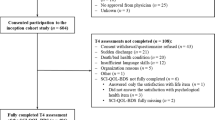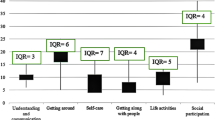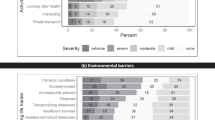Abstract
Study design: Multicentered follow-up with centralized data collection based on retrospective study.
Objectives: To assess the outcome in a population of patients with spinal cord injury (SCI). The assessed outcomes are mortality, state of health, occupation, mobility, autonomy, social and partner relationships, quality of life (QoL), with the identification of any relation between results and demographic–clinical data.
Setting: Two rehabilitation centers (Udine and Trevi) and a Spinal Injuries Unit (Torino).
Methods: A total of 251 patients with SCI discharged after first hospitalization from rehabilitation facilities between 1989 and 1994 were enrolled. A questionnaire was administered by telephone.
Results: During the time between discharge and follow-up, 25 out of the 251 patients had died, yielding a mortality rate of 9.96%. A total of 80 patients did not give their consent. The 146 patients' mean interval from discharge from the rehabilitation facility was 6 years. At least 25% has been hospitalized again. The descriptive analysis also shows that 29.5% of patients were working, 48.6% were able to drive, 63.7% would leave their home alone, 61% would leave home every day, 63% reported of a change in their relationships, 48.6% were happy with their love lives. Significant correlations have emerged between certain items and age: those who had a job, who could drive, were more autonomous and had a higher QoL are generally younger. Level of injury appear to be only associated with the degree of autonomy, which seems to be inferior for tetraplegic subjects. The injury's completeness and etiology do not exhibit any correlation. QoL is associated with a number of items: a higher QoL is linked to the possibility to work, especially if it is a paid job, to the ability to drive, to a good degree of autonomy, to a lack of change in the social and partner relationships, and to a satisfactory love life.
Conclusion: At 6 years after discharge from rehabilitations, the effects of trauma on work and social and partner relationships, domains correlated with autonomy and QoL, are evident. Further investigation by means of a prospective study over the years are therefore necessary.
Similar content being viewed by others
Log in or create a free account to read this content
Gain free access to this article, as well as selected content from this journal and more on nature.com
or
References
DeVivo MJ, Krause JS, Lammertse DP . Recent trends in mortality and causes of death among persons with spinal cord injury. Arch Phys Med Rehabil 1999; 80: 1411–1419.
Hartkopp A, Bronnum-Hansen H, Seidenschnur AM, Biering-Sorensen F . Survival and cause of death after traumatic spinal cord injury. A long-term epidemiological survey from Denmark. Spinal Cord 1997; 35: 76–85.
Yeo JD et al. Mortality following spinal cord injury. Spinal Cord 1998; 36: 329–336.
McColl MA et al. Expectations of life and health among spinal cord injured adults. Spinal Cord 1997; 35: 818–828.
Frankel HL et al. Long-term survival in spinal cord injury: a fifty year investigation. Spinal Cord 1998; 36: 266–274.
Samsa GP, Patrick CH, Feussner JR . Long-term survival of veterans with traumatic spinal cord injury. Arch Neurol 1993; 50: 909–914.
Dijkers M . Correlates of life satisfaction among persons with spinal cord injury. Arch Phys Med Rehabil 1999; 80: 867–876.
Lotta S et al. Family, vocational and social reintegration of spinal cord injured patients following discharge from a rehabilitation centre. Eur Medicophys 1999; 35: 49–59.
Richards JS et al. Access to environment and life satisfaction after spinal cord injury. Arch Phys Med Rehabil 1999; 80: 1501–1506.
Noreau L, Fougeyrollas P . Long-term consequences of spinal cord injury on social participation: the occurrence of handicap situations. Disabil Rehabil 2000; 22: 170–180.
Wehman P et al. Employment satisfaction of individuals with spinal cord injury. Am J Phys Med Rehabil 2000; 79: 161–169.
Tomassen CD, Post MWM, van Asbeck FWA . Return to work after spinal cord injury. Spinal cord 2000; 38: 51–55.
Krause JS et al. Employment after spinal cord injury: an analysis of cases from the model spinal cord injury systems. Arch Phys Med Rehabil 1999; 80: 1492–1500.
Conroy L, McKenna K . Vocational outcome following spinal cord injury. Spinal Cord 1999; 37: 624–633.
Craig A, Hancock K, Dickson H . Improving the long-term adjustment of spinal cord injured persons. Spinal cord 1999; 37: 345–350.
Dijkers M, Yavuzer G . Short version of the telephone motor functional independence measure for use with persons with spinal cord injury. Arch Phys Med Rehabil 1999; 80: 1477–1484.
Nyland J et al. Preserving transfer independence among individuals with spinal cord injury. Spinal Cord 2000; 38: 649–657.
Scivoletto G, Petrelli A, Di Lucente L, Castellano V . Psychological investigation of spinal cord injury patients. Spinal Cord 1997; 35: 516–520.
Yim SY et al. Quality of marital life in Korean spinal cord injury patients. Spinal Cord 1998; 36: 826–831.
Kreuter M, Sullivan M, Dahllof AG, Siosteen A . Partner relationships, functioning, mood and global quality of life in persons with spinal cord injury and traumatic brain injury. Spinal Cord 1998; 36: 252–261.
Westgren N, Levi R . Motherhood after traumatic spinal cord injury. Paraplegia 1994; 32: 517–523.
Nelson AL . Patients' perspectives of a spinal cord injury unit. SCI Nurs 1990; 7: 44–63.
Pentland W, Harvey AS, Smith T, Walker J . The impact of spinal cord injury on men's time use. Spinal Cord 1999; 37: 786–792.
Tasiemski T, Bergstrom E, Savic G, Gardner BP . Sport, recreation and employment satisfaction of individuals with spinal cord injury. Spinal Cord 2000; 38: 173–184.
Taricco M et al. The social and vocational outcome of spinal cord injury patients. Paraplegia 1992; 30: 214–219.
Kiyono Y et al. Car-driving abilities of people with tetrapelgia. Arch Phys Med Rehabil 200l; 82: 1387–1392.
Ville I, Ravaud JF . Subjective well-being and severe motor impairments: the Tetrafigap survey on the long-term outcome of tetraplegic spinal cord injured persons. Soc Sci Med 2001; 52: 369–384.
Kreuter M . Spinal cord injury and partner relationships. Spinal Cord 2000; 38: 2–6.
Hallin P, Sullivan M, Kreuter M . Spinal cord injury and quality of life measures: a review of instrument psycometric quality. Spinal Cord 2000; 38: 509–523.
Vaidyananthan S et al. Effect of intermittent urethral catheterization and oxybutynin bladder instillation on urinary continence status and quality of life in a selected group of spinal cord injury patients with neuropathic bladder dysfunction. Spinal Cord 1998; 36: 409–414.
Stensman R . Adjustment to traumatic spinal cord injury. A longitudinal study of self-reported quality of life. Paraplegia 1994; 32: 416–422.
Manns P, Chad K . Determining the relation between quality of life, handicap, fitness, and physical activity for persons with spinal cord injury. Arch Phys Med Rehabil 1999; 80: 1566–1571.
Westgren N, Levi R . Quality of life and traumatic spinal cord injury. Arch Phys Med Rehabil 1998; 79: 1433–1439.
Kennedy P, Rogers B . Reported quality of life of people with spinal cord injury: a longitudinal analysis of the first 6 months post-discharge. Spinal Cord 2000; 38: 498–503.
Acknowledgements
We thank Daniel Loria, Valeria Chiapatti, Maria Luisa Macchia (Spinal Injuries Unit of Torino), Marsilio Saccavini, Luigi Lovati, Agostino Zampa (Rehabilitation Centre of Udine), Mauro Zampolini and Silvano Baratta (Rehabilitation Centre of Trevi), Vladimiro Kosic (Paraplegic Association Friuli Venezia Giulia) for identifying the patients to be interviewed, and P Collodi and S Traietti (Social Cooperative ‘M Iacontino’ Centre for autonomy – Paraplegic Association Roma and Lazio) for the interviews.
Author information
Authors and Affiliations
Rights and permissions
About this article
Cite this article
Franceschini, M., Di Clemente, B., Rampello, A. et al. Longitudinal outcome 6 years after spinal cord injury. Spinal Cord 41, 280–285 (2003). https://doi.org/10.1038/sj.sc.3101457
Published:
Issue date:
DOI: https://doi.org/10.1038/sj.sc.3101457
Keywords
This article is cited by
-
Characteristics of persons with spinal cord injury who drive in Malaysia and its barriers: a cross sectional study
Spinal Cord (2018)
-
A comparison of perceptions of quality of life among adults with spinal cord injury in the United States versus the United Kingdom
Quality of Life Research (2017)
-
Several time indicators and Barthel index relationships at different spinal cord injury levels
Spinal Cord (2015)
-
The association of assistive mobility devices and social participation in people with spinal cord injuries
Spinal Cord (2014)
-
Impact of quality improvement strategies on the quality of life and well-being of individuals with spinal cord injury: a systematic review protocol
Systematic Reviews (2013)



